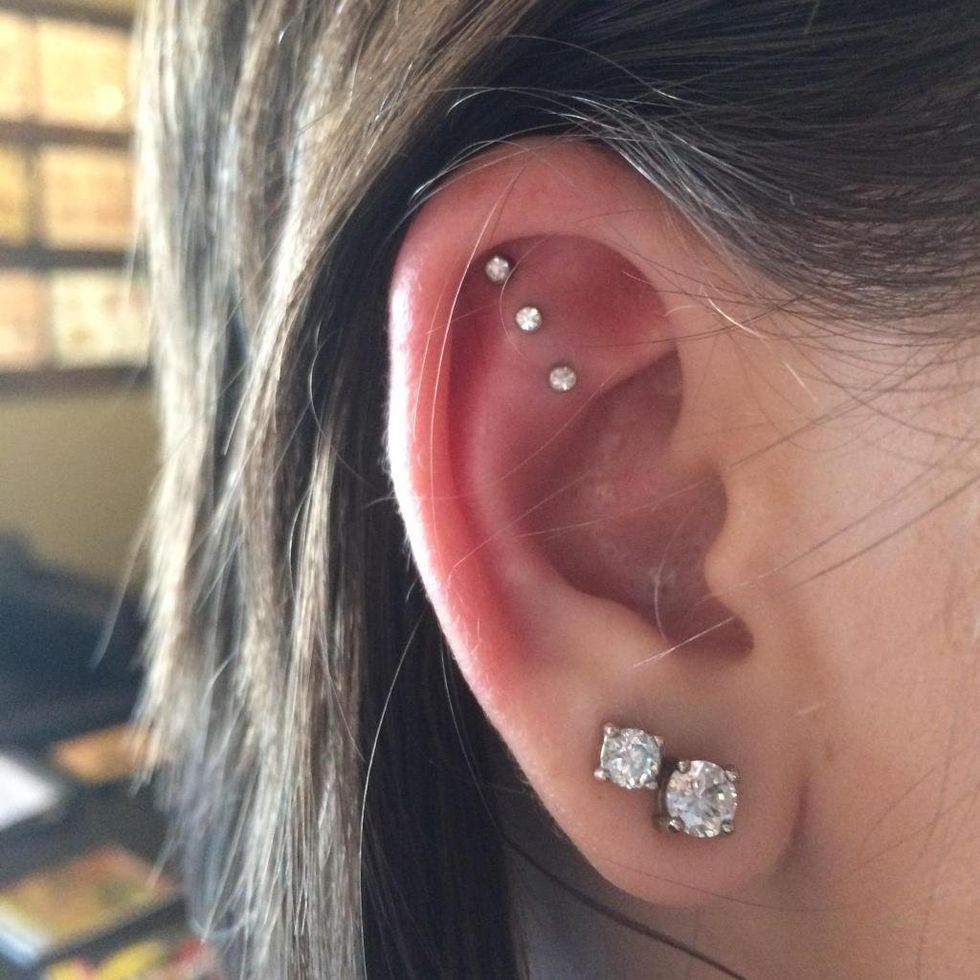Cartilage piercings are very cute and as popular as ever. I, myself, have six cartilage earrings, six earrings in my ear lobes, and a nose ring. But there are some things that you should know before you consider getting your cartilage pierced and a few things you need to know for after you decide to take the leap.
Before
1. DO NOT GET YOUR CARTILAGE PIERCED ANYWHERE THAT USES A GUN!!
Yes, I am yelling. This is the first and most important thing to know about getting your cartilage pierced. Guns use a forceful motion to clamp down on the ear and pierce the skin. While this is a quick and relatively painless way to get your ear lobe pierced, this is dangerous to do on your cartilage. Piercing guns shatter the cartilage causing more pain, longer healing times, improper healing, and possibly infection. As a bonus, piercing guns do not use the appropriate type and length of jewelry for cartilage, so this method runs the risk of the earring being pulled into the wound as it heals.
2. Do your research and find a highly rated and clean tattoo shop to do the piercing.
The piercers that work at tattoo shops have been trained in how to properly pierce cartilage (and really anything else you want pierced). They take their time, make sure everything is sterilized, and give careful instructions on aftercare. Plus, if something happens after you get your cartilage pierced, you can usually go back to your licensed piercer, to know if what you are facing is a real problem or something that will resolve itself, something a person with only minor piercing knowledge could not do.
3. Different areas of the ear hurt more than others to have pierced.
While this may seem obvious, this was a little more shocking to me in the moment. I have six cartilage earrings in total, three on each ear (and twelve earrings in total). When I got the triple helix piercing done (top photo), the top earring was a breeze, but the bottom one where my cartilage was considerably thicker hurt like crazy. It took longer for the bottom piercing to go through than the top. When I had the forward triple helix done (bottom photo), while the cartilage was all the same thickness—relatively thin in comparison to other parts of my ear—these were also the most painful of ALL of my piercings. Because of the ear behind this part of the cartilage and the small surface area, the piercer had to very careful and go very slow. While I love my forward helix earrings, I do tend to steer people away from getting this done (because it hurts really freakin’ bad).

4. Only get one side of your head pierced at a time.
Okay, so if you’re like me and you want multiple cartilage piercings, then plan to only do one side at a time. Why? Because you need another side to sleep on. Not only will you be physically unable to put that much pressure on the side of your head with your new piercing but sleeping on a new piercing can actually be harmful to the healing process. It can make inflammation worse or cause your jewelry to move too much.
After
1. Saline pressurized wound wash will be your best friend.
While this is something that you need to do early in the healing process, using saline is something you should continue to do. If you get a cartilage piercing like the triple forward helix, this is especially helpful. I cannot take those three earrings out at all, I have to go to a piercer for that. This makes it very hard to clean. But I use my trusty can of pressurized saline solution to spray into that part of my ear and then use a cotton swab to help clean it out.
2. Don't twist your earrings.
This is something your piercer will tell you about aftercare too, but don’t do this. The skin will not become adhered to the earring at all, so twisting it serves no purpose except to pull at and irritate the skin, not allowing the healing process to happen. Your skin won’t heal onto the earring, it will heal around it.
3. Be ready to live with your cartilage piercings because you can't take them out.
This is very important to consider, especially if you play a sport or have a job where management isn't okay with cartilage earrings. On average, if I take an earring out of my cartilage, the hole will start closing in about 30 minutes. After about 12-24 hours, you have to go back into the piercer to get the hole stretched open again (and this is only something you can do if you had the piercing done with a gauged needle and not a gun because the gauged needle leaves enough room for this). I have had all six of cartilage piercings in everyday for about 4 years now. This goes for really any piercing besides earlobe earrings. I have a nose rings also and after about an hour it starts to hurt to put it back in. After 24 hours, it can make me tear up when I have to put it back in.
As someone with 12 earrings and 1 nose ring, I obviously like piercings and am not scared of needles. But, I do suggest that you do your research. Make sure you know what you want and sit on the idea for a while. Then, make sure you have everything you need to assure that you heal completely and fully.


















